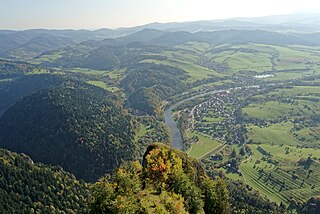
The Dunajec is a river running through northeastern Slovakia and southern Poland. It is also regarded as the main river of the Goral Lands. It is a right tributary of the Vistula River. It begins in Nowy Targ at the junction of two short mountain rivers, Czarny Dunajec and Biały Dunajec. Dunajec forms the border between Poland and Slovakia for 17 kilometres (11 mi) in the Pieniny Środkowe range, east of the Czorsztyn reservoir.

Podhale, sometimes referred to as the Polish Highlands, is Poland's southernmost region. The Podhale is located in the foothills of the Tatra range of the Carpathian Mountains. It is the most famous region of the Goral Lands which are a network of historical regions inhabited by Gorals.

Pieniny National Park is a protected area located in the heart of the Pieniny mountains in the southernmost part of Poland. It is the oldest national park in Poland. Administratively, the park lies in the Lesser Poland Voivodeship on the border with Slovakia. Its head office is in Krościenko nad Dunajcem.

Pieniny National Park is a national park in northern Slovakia. The park is located in the eastern Pieniny Mountains on the border with Poland. It is the smallest national park in Slovakia with an area of 37.49 km2 (14.48 mi2) and a buffer zone of 224.44 km2 (86.66 mi2). The park is located in the Slovak districts of Kežmarok and Stará Ľubovňa in the Prešov Region.

The Pieniny is a mountain range in the south of Poland and the north of Slovakia. It is classified within the eastern section of the Western Beskids.

The Nowy Sącz Royal Castle is a mediaeval castle in the city of Nowy Sącz in Poland. The partially restored ruins of the castle date back to the 14th century during the reign of Casimir III the Great.
The Kostka Napierski uprising was a peasant revolt in Poland in 1651.

The Lviv High Castle is a historic castle located on the top of the Castle Hill of the city of Lviv, Ukraine. It is currently the highest point in the city, 413 metres (1,355 ft) above sea level. The castle currently stands in ruins.

Czorsztyn is a village in Poland, in Lesser Poland Voivodeship, Nowy Targ County. The village lies in Pieniny, the mountain range on the current Polish-Slovak border. It is famous for the ruins of a 14th-17th-century castle, which was the scene of the Kostka-Napierski Uprising in 1651.
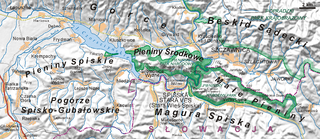
Zamagurie is a region in the Goral Lands area in the north of the Spiš region, between the Spišská Magura in the south, the Dunajec river in the north and the Białka river in the west. It is divided between the Prešov Region of Slovakia and the Lesser Poland Voivodeship of Poland and is further divided between the Slovak districts of Stará Ľubovňa and Kežmarok and Polish gminas of Bukowina Tatrzańska, Nowy Targ and Łapsze Niżne. The centre of the region is the Slovak town Spišská Stará Ves, which is just near the border. The region also used to be one of the official tourist regions of Slovakia until 2004.
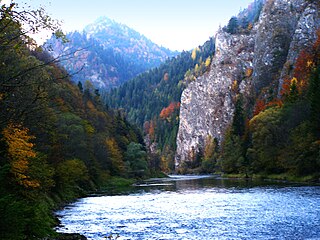
The Dunajec River Gorge runs through the Pieniny Mountains in the south of Poland and the north of Slovakia. The gorge is characterized by some of the most interesting geological and geomorphological structures and area-specific natural ecosystems with little anthropogenic influence. It is featured on UNESCO's Tentative List of World Heritage Sites in Poland.

Niedzica is a resort village in Nowy Targ County of Lesser Poland province, Poland, located on the banks of Lake Czorsztyn. It is famous for Niedzica Castle, also known as Dunajec Castle. It lies approximately 6 kilometres (4 mi) north-east of Łapsze Niżne, 21 km (13 mi) east of Nowy Targ, and 75 km (47 mi) south of the regional capital Kraków.

Niedzica Castle, also known as Dunajec Castle, is located in the southernmost part of Poland in Niedzica. It was erected between the years 1320 and 1326 by Kokos of Brezovica on the site of an ancient stronghold surrounded by earthen walls in the Pieniny mountains.
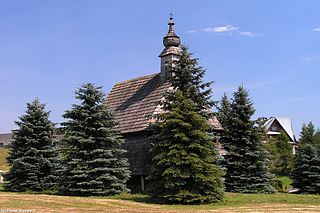
Maniowy is a village in southern Poland situated in the Lesser Poland Voivodeship about 19 kilometres (12 mi) east of Nowy Targ and 71 km (44 mi) south of the regional capital Kraków. It has been the seat of the district of Gmina Czorsztyn since 1993.

Trzy Korony is the summit of the Three Crowns Massif, an independent portion of a range called Pieniny Mountains in the south of Poland. Trzy Korony forms the central part of a compact group of connected mountains known as Pieniny Środkowe, consisting mainly of the limestone and dolomite rock strata. Trzy Korony is located within the Pieniny National Park in Lesser Poland Voivodeship.

Červený Kláštor is a medieval monastery located in Slovakia. It is located near the village of Červený Kláštor within the Pieniny Mountains, next to the Dunajec River.
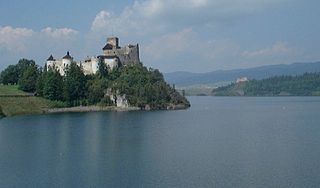
Lake Czorsztyn is a man-made reservoir on the Dunajec river, southern Poland, between the Pieniny and the Gorce Mountains. It exists due to a dam in the village of Niedzica.
The Dunajec river castles is a chain of thirteen medieval castles, built in southern Lesser Poland, along the Dunajec river. The castles protected the border between the Kingdom of Poland and the Kingdom of Hungary, as well as a very important international trade route, which went along the Dunajec and the Poprad all the way down to the Danube river. Most of the castles are in ruins now, and some have disappeared. Their history dates back to the period known as the Fragmentation of Poland in the early 12th century, when, according to his will, known as the Testament of Bolesław III Wrymouth, the country was divided into several provinces. The Dunajec river castles were located on the territory of two castellanies, Wojnicz and Nowy Sącz, in the extreme south of the Seniorate Province.

The Kotuńka Rock is a prominent rock found in the centre of the current of the river Dunajec just before the entry into Szczawnica. Built from limestone, the rock is well seen from the road and is a characteristic landmark in the area. Just above the rock the Grajcarek flows into the Dunajec. On from the rock is a bridge, after which begins the Pieniny Trail Road which heads to a border crossing.

The Orava-Nowy Targ Basin is the northern, lowest part of the Podhale-Magura Area, between the Western Beskids in the north and the Spisko-Gubałowski Highlands in the south.



















